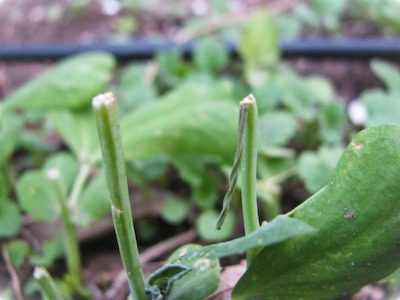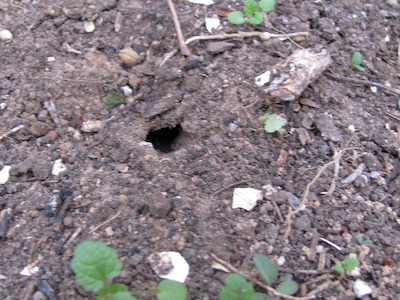Last month I noticed that a two foot section of sugar snap peas had been cut down almost to the ground. I inspected the damage expecting to see evidence of squirrels or some other mammal, but instead discovered that my arch-nemesis, the leaf cutting ant, had returned. I saw them methodically carrying away pieces of pea leaves, bigger than their own bodies.
I have a leaf cutting ant nest somewhere on my property, probably underneath my front porch. I can’t determine the exact location of the nest because their tunnels can extend a hundred feet or more. I’ve written about the ants before here, and have mostly learned to live with them. They remain dormant most of the time, but make appearances several times a year. Each time that they emerge they choose one type of plant to eat, ignoring the other vegetation. This time it was peas.
Because the ants don’t actually eat the leaves, but instead use them to grow fungus, most insect controls don’t work on them. For example, both Noel and I have had excellent results spraying neem oil on our plants to control leaf eating insects. But for the neem to be effective, the insects must ingest it. This doesn’t happen with the ants.
Luckily this time I noticed the ant outbreak before they had destroyed all of the peas. I found that they had only tunneled into the pea bed in one location. I poured orange oil into the hole. I returned to the bed two days later and did not see any further damage. I did, however, find about a dozen ants wandering around the bed still carrying now shriveled pieces of leaf. Apparently I had severed their only connection with the mother colony.
I won one round in my struggle with the ants. But I know that they will be back. And from past experience, I also know that they usually get what they want.



You might also try sprinkling black pepper in and around your pea plants. We use that to discourage sugar ants that we get regularly in the spring. It works well for us.
Interesting post. Thanks for sharing. DE dusted on and around the plants might help as well.
I will be interested to see how you deal with these pests over time. My goal has always been to keep the damage to a minimum. I have found preditors for most of pests, but ants, that would be anew one for me. I am anxious to see how you solve this, or combat the problem.
Thanks for the suggestions. I’ve tried diatomaceous earth (DE) as well as several other control methods with leaf cutting ants in past years with no noticeable effect. I’ve used BugBarrier Tree Bands, http://www.treebands.com/home, to protect my fruit trees with great success, but they need to wrap around a trunk and don’t work with garden plants.
Amdro has a product called “Ant Block” recommended for leaf cutter ants and it works. I have been dealing with these for 35 years and this is the first thing that actually works. If you don’t use pesticides, sorry.
Ok everybody try this. In a quart size spray bottle add one packet of dry active yeast. When you find the ants harvesting your roses, peaches or crape myrtles spray the ants and their bounty with this yeast water mix. Let them take this home to mama, I just started this last week and found it to have impressive stopping power, I am dealing with 5 new holes per day. My hopes are to ruin the food cache with this new yeast thus killing the colony. Spray the ground around your plants also. The colony that’s been eating on me cant be located just the new holes. I am adding just a pinch of sugar to help it stick and feed the yeast.
I have been plagued with leaf cutter ants for a lifetime and tried everything the extension agent suggested, near zero results, new hole and a new charge of ants next day. I probably killed some ants but stopped nothing. In researching I found an article on the net from Guatemala/Costa Rica area and they used yeast. I’ll try anything at this point right so I took some yeast put it in a cheap spray bottle and coated the ant pack train and the hole, they went back in the hole and have not returned. I have hopes the yeast will grow along their tunnel and ruin/contaminate their food cache (fungus) deep in the bowels of the earth. I also sprayed around the base of the roses, peaches and crape myrtles. I’m two weeks into this experiment and I think it has as good if not better results in keeping them off my stuff as compared to the powders or pesticide sprays used to date. Plus I feel good using it around the pets, chickens etc,,, It does not kill anything by contact.
Rick, I have been fighting these leaf cutters for 10 years!! I live in the country so fighting pests is an endless battle. I have just come to live in harmony with the ones I can. 10 years and this is the first year I have been able to see blooms on my crape myrtle. I thought DE was the answer. Been sprinkling it around the base of tree/bush this year and it seems to be keeping them away. But today I noticed they are now attacking what little lawn we have. I spread DE all along their path and all around every hole I could find. 6 hours later they are still going strong. If this doesn’t work I want to try your yeast method. Anxious to hear how it went.
Trying to get away from too many chemicals since so far I have not seen positive results with them. But willing to try the amdro ant block product listed above.
And by the way. Most articles say these guys only work at night. Today in 90 degree weather I have observed them harvesting since at least 8am till now 5pm. They will strip my entire crape myrtle tree (15ft) in less than 24 hrs. Amazing. I keep loosing oak trees. I wonder if they are causing that too. We are on 10 acres so that is a lot of ground to cover.
Tamie, the yeast had a definite affect and they quit using those holes but I now have found I am fighting two colonies and a kazillion workers. When I water they come to the wet earth. Yeast is too slow to give result and save plants. I have 30 plus fruit trees and the same in roses and also crapes, they will stress and die in this heat . It’s 102 right now. I am using a product thats used to control flies in stables ,its granular and I cover it with an aluminum pan.
Very hot here too. Just hit 101. Interesting about the fly control product. You say cover with a pan so are they coming and getting it like bait? And what is it called? I am hoping to pick up some of the “Ant Block” this evening or tomorrow.
I also found a new ant problem today. It is causing all the leaves from my Vinca plants to drop off sections at a time. At first I thought it was caused by cut ants but then I noticed the leaves have fallen off as whole leaves and not cuttings and they are not being carried off. Then I witnessed ants (not sure what kind)moving white objects around the leaves remaining on the side of the plant still standing. I took pics and video of what looks like a winged ant laying eggs and the others carrying them off. Looks like maybe the ants are sucking something from the plant during this process causing the leaves to then fall off. Need to see where I can post pictures.
Here is a link to the video I describe above
http://youtu.be/685piebAhRk
Put the fly bait in every ant hole and shade it from the sun.
rick@williamscreektradingcompany.com It would be easier to correspond here.
would like to know how the yeast project work out.
Hey Tony, Yes it worked and they never came back to the treated holes. They moved to another area and launched a nightime raid stripping peach trees (10) and seem to be really packing in the groceries for winter right now. I am still battling multiple holes and have asked neighbors for their assistance since I don’t know where the main den is, it’s not on my property. My next attempt will be co2 a heavy gas etc……
I have these =%#%/^^***&/”-$!!!!’s in my veg. Garden
been fighting them off my roses for 3 years. A neighbor nextdoor has a huge colony, but he is grazing cows there. I dont suppose there is any way to kill these sci fi things in a pasture. Catch 22, right??
How do you mix up the yeast technoque and apply it?